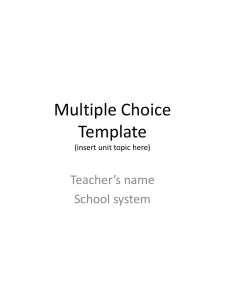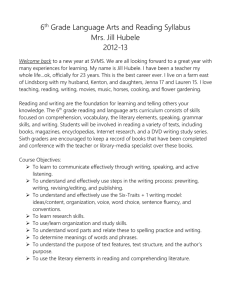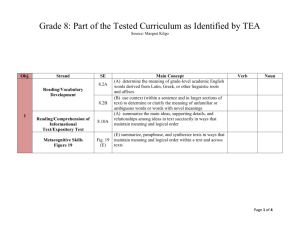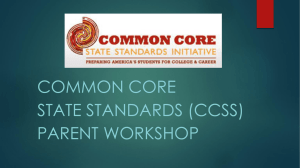Unwrapped Standards: RL.3.1 - Ask and answer questions to
advertisement
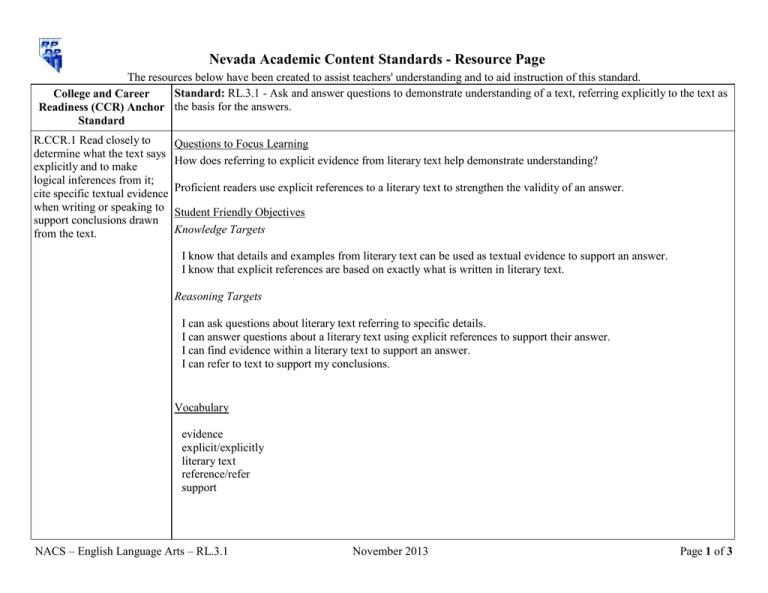
Nevada Academic Content Standards - Resource Page The resources below have been created to assist teachers' understanding and to aid instruction of this standard. Standard: RL.3.1 - Ask and answer questions to demonstrate understanding of a text, referring explicitly to the text as College and Career Readiness (CCR) Anchor the basis for the answers. Standard R.CCR.1 Read closely to determine what the text says explicitly and to make logical inferences from it; cite specific textual evidence when writing or speaking to support conclusions drawn from the text. Questions to Focus Learning How does referring to explicit evidence from literary text help demonstrate understanding? Proficient readers use explicit references to a literary text to strengthen the validity of an answer. Student Friendly Objectives Knowledge Targets I know that details and examples from literary text can be used as textual evidence to support an answer. I know that explicit references are based on exactly what is written in literary text. Reasoning Targets I can ask questions about literary text referring to specific details. I can answer questions about a literary text using explicit references to support their answer. I can find evidence within a literary text to support an answer. I can refer to text to support my conclusions. Vocabulary evidence explicit/explicitly literary text reference/refer support NACS – English Language Arts – RL.3.1 November 2013 Page 1 of 3 Teacher Tips Applying Question Answer Relationships - This lesson is designed for struggling readers to learn about four different types of questions, ranging in difficulty from those with answers that can be found in the text to those that require inferences. Students begin with a guided viewing of David Wiesner’s Tuesday, a wordless picture book, to learn and categorize question types then apply what they learned to an independent reading of Istvan Banyai's Zoom. Includes student assessments. (Source: Read Write Think, International Reading Association, NCTE) Guided Reading Strategies - In this lesson, students are introduced to a questioning strategy as they read Henry and Mudge and the Starry Night as a whole group. Students apply this strategy during rereading and can get additional practice in small groups with other texts. Resources include sample explicit questions and an interactive program for students to create flash card questions. (Source: Read Write Think, International Reading Association, NCTE) QAR- Enhancing Comprehension - In this 2005 article, QAR: Enhancing Comprehension and Test Taking Across Grades and Content Areas, Taffy Raphael and Kathryn Au describe how Question-Answer Relationships (QARs) can help provide a framework for questioning activities and make the invisible processes underlying effective reading comprehension more visible to students. Includes visual cues to teach strategies to students. Questioning- A Comprehension Strategy - In this lesson, students learn the difference between thin (factual) and thick (inferential) questions and how to monitor their comprehension by using question webs in journals during smallgroup reading. Readers are engaged in active comprehension and reciprocal teaching strategies. It can be applied to a variety of texts used in small group reading. Referenced resource: Oczkus, L.D. (2003). The four reciprocal teaching strategies. In Reciprocal teaching at work: Strategies for improving reading comprehension. Newark, DE: International Reading Association. (Source: Read Write Think, International Reading Association, NCTE) Strategies to Teach Comprehension - This 2004 article, Seven Strategies to Teach Students Text Comprehension, by C.R. Adler discusses the importance of comprehension strategy instruction in helping students become purposeful readers who are responsible for their own comprehension. Two of the strategies discussed include answering and generating questions and there is a simple overview of the Question-Answer Relationship Strategy (QAR). Vertical Progression RL.K.1 - With prompting and support, ask and answer questions about key details in a text. RL.1.1 - Ask and answer questions about key details in a text. RL.2.1 - Ask and answer such questions as who, what, where, when, why, and how to demonstrate understanding of key details in a text. RL.4.1 - Refer to details and examples in a text when explaining what the text says explicitly and when drawing inferences from the text. NACS – English Language Arts – RL.3.1 November 2013 Page 2 of 3 RL.5.1 - Quote accurately from a text when explaining what the text says explicitly and when drawing inferences from the text. RL.6.1 - Cite textual evidence to support analysis of what the text says explicitly as well as inferences drawn from the text. RL.7.1 - Cite several pieces of textual evidence to support analysis of what the text says explicitly as well as inferences drawn from the text. RL.8.1 - Cite the textual evidence that most strongly supports an analysis of what the text says explicitly as well as inferences drawn from the text. RL.9-10.1 - Cite strong and thorough textual evidence to support analysis of what the text says explicitly as well as inferences drawn from the text. RL.11-12.1 - Cite strong and thorough textual evidence to support analysis of what the text says explicitly as well as inferences drawn from the text, including determining where the text leaves matters uncertain. The above information and more can be accessed for free on the Wiki-Teacher website. Direct link for this standard: RL.3.1 NACS – English Language Arts – RL.3.1 November 2013 Page 3 of 3

